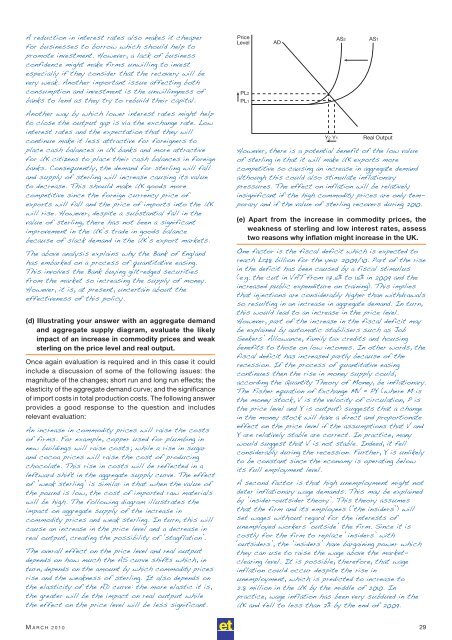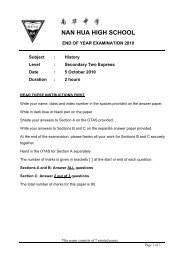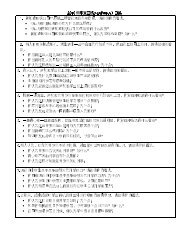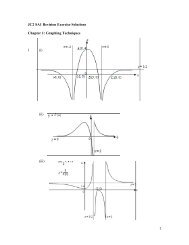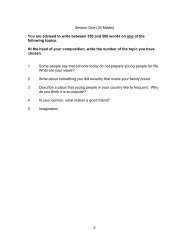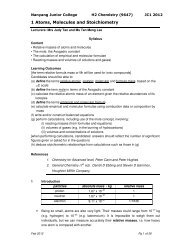Eco Today - Mar10:ET Master Page 2007 - ASKnLearn
Eco Today - Mar10:ET Master Page 2007 - ASKnLearn
Eco Today - Mar10:ET Master Page 2007 - ASKnLearn
You also want an ePaper? Increase the reach of your titles
YUMPU automatically turns print PDFs into web optimized ePapers that Google loves.
A reduction in interest rates also makes it cheaper<br />
for businesses to borrow which should help to<br />
promote investment. However, a lack of business<br />
confidence might make firms unwilling to invest<br />
especially if they consider that the recovery will be<br />
very weak. Another important issue affecting both<br />
consumption and investment is the unwillingness of<br />
banks to lend as they try to rebuild their capital.<br />
Price<br />
Level<br />
PL2<br />
PL1<br />
AD<br />
AS2<br />
AS1<br />
Another way by which lower interest rates might help<br />
to close the output gap is via the exchange rate. Low<br />
interest rates and the expectation that they will<br />
continue make it less attractive for foreigners to<br />
place cash balances in UK banks and more attractive<br />
for UK citizens to place their cash balances in foreign<br />
banks. Consequently, the demand for sterling will fall<br />
and supply of sterling will increase causing its value<br />
to decrease. This should make UK goods more<br />
competitive since the foreign currency price of<br />
exports will fall and the price of imports into the UK<br />
will rise. However, despite a substantial fall in the<br />
value of sterling, there has not been a significant<br />
improvement in the UK’s trade in goods balance<br />
because of slack demand in the UK’s export markets.<br />
The above analysis explains why the Bank of England<br />
has embarked on a process of quantitative easing.<br />
This involves the Bank buying gilt-edged securities<br />
from the market so increasing the supply of money.<br />
However, it is, at present, uncertain about the<br />
effectiveness of this policy.<br />
(d) Illustrating your answer with an aggregate demand<br />
and aggregate supply diagram, evaluate the likely<br />
impact of an increase in commodity prices and weak<br />
sterling on the price level and real output.<br />
Once again evaluation is required and in this case it could<br />
include a discussion of some of the following issues: the<br />
magnitude of the changes; short run and long run effects; the<br />
elasticity of the aggregate demand curve; and the significance<br />
of import costs in total production costs. The following answer<br />
provides a good response to the question and includes<br />
relevant evaluation:<br />
An increase in commodity prices will raise the costs<br />
of firms. For example, copper used for plumbing in<br />
new buildings will raise costs; while a rise in sugar<br />
and cocoa prices will raise the cost of producing<br />
chocolate. This rise in costs will be reflected in a<br />
leftward shift in the aggregate supply curve. The effect<br />
of ‘weak sterling’ is similar in that when the value of<br />
the pound is low, the cost of imported raw materials<br />
will be high. The following diagram illustrates the<br />
impact on aggregate supply of the increase in<br />
commodity prices and weak sterling. In turn, this will<br />
cause an increase in the price level and a decrease in<br />
real output, creating the possibility of ‘stagflation’.<br />
The overall effect on the price level and real output<br />
depends on how much the AS curve shifts which, in<br />
turn, depends on the amount by which commodity prices<br />
rise and the weakness of sterling. It also depends on<br />
the elasticity of the AD curve: the more elastic it is,<br />
the greater will be the impact on real output while<br />
the effect on the price level will be less significant.<br />
Y2 Y1<br />
Real Output<br />
However, there is a potential benefit of the low value<br />
of sterling in that it will make UK exports more<br />
competitive so causing an increase in aggregate demand<br />
although this could also stimulate inflationary<br />
pressures. The effect on inflation will be relatively<br />
insignificant if the high commodity prices are only tem -<br />
porary and if the value of sterling recovers during 2010.<br />
(e) Apart from the increase in commodity prices, the<br />
weakness of sterling and low interest rates, assess<br />
two reasons why inflation might increase in the UK.<br />
One factor is the fiscal deficit which is expected to<br />
reach £178 billion for the year 2009/10. Part of the rise<br />
in the deficit has been caused by a fiscal stimulus<br />
(e.g. the cut in VAT from 17.5% to 15% in 2009 and the<br />
increased public expenditure on training). This implies<br />
that injections are considerably higher than withdrawals<br />
so resulting in an increase in aggregate demand. In turn,<br />
this would lead to an increase in the price level.<br />
However, part of the increase in the fiscal deficit may<br />
be explained by automatic stabilisers such as Job<br />
Seekers’ Allowance, family tax credits and housing<br />
benefits to those on low incomes. In other words, the<br />
fiscal deficit has increased partly because of the<br />
recession. If the process of quantitative easing<br />
continues then the rise in money supply could,<br />
according the Quantity Theory of Money, be inflationary.<br />
The Fisher equation of Exchange MV = PY (where M is<br />
the money stock, V is the velocity of circulation, P is<br />
the price level and Y is output) suggests that a change<br />
in the money stock will have a direct and proportionate<br />
effect on the price level if the assumptions that V and<br />
Y are relatively stable are correct. In practice, many<br />
would suggest that V is not stable. Indeed, it fell<br />
considerably during the recession. Further, Y is unlikely<br />
to be constant since the economy is operating below<br />
its full employment level.<br />
A second factor is that high unemployment might not<br />
deter inflationary wage demands. This may be explained<br />
by ‘insider-outsider theory’. This theory assumes<br />
that the firm and its employees ( ‘the insiders’ ) will<br />
set wages without regard for the interests of<br />
unemployed workers ‘outside’ the firm. Since it is<br />
costly for the firm to replace ‘insiders’ with<br />
‘outsiders’, the ‘insiders’ have bargaining power which<br />
they can use to raise the wage above the marketclearing<br />
level. It is possible, therefore, that wage<br />
inflation could occur despite the rise in<br />
unemployment, which is predicted to increase to<br />
2.8 million in the UK by the middle of 2010. In<br />
practice, wage inflation has been very subdued in the<br />
UK and fell to less than 2% by the end of 2009.<br />
M ARCH 2010 29


